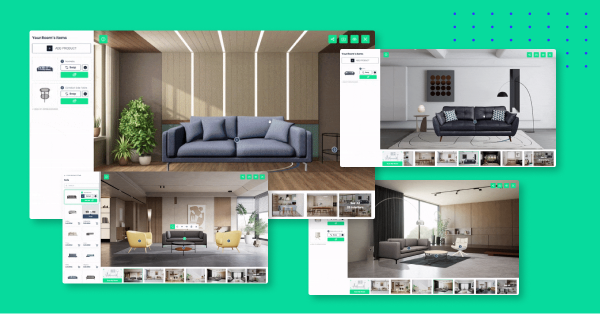How AR Helped Build.com Reduce Return Rates By 22%
Augmented reality is becoming an increasingly important part of our daily lives. In fact, as of early 2023, more than a billion people are actively using AR.
In the mid-2010s, major online retailers saw significant promise in this technology and began implementing AR solutions into their business processes.
However, most businesspeople are still cautious. There are several reasons for this, including a lack of competence, skepticism about its effectiveness, and concerns about its high cost.
Our series of use cases is designed for such people. It will show you how companies in the retail industry have implemented AR technology into their operations. It will also cover aspects about what motivated them, problems they encountered during the development process, and what results did it bring them?
By reading these materials, you can determine whether your company should invest in AR solutions.
In this use-case, we look at Build.com - the largest online-only seller of home improvement products in the US in 2023, with an estimated annual revenue of $301.6 million.

The Situation

As the Chief Technology Officer of Build.com, Dan Davis understood the importance of providing customers with a seamless online shopping experience.
While the benefits of being an online-only retailer, such as lower prices for customers, were clear, the lack of physical interaction with products was a significant drawback.
Customers had to rely solely on product images, descriptions, and reviews to make informed purchasing decisions. As a result, engagement rates, product discovery, and sales conversion rates were lower than anticipated, and many customers had to return items because they did not look or function as expected.
In 2017, Build.com decided to fix the situation by integrating an AR solution. By leveraging this technology, the company wanted to improve its business metrics and provide customers with a more immersive and personalized shopping experience.
The Solution
Companies that want to implement AR solutions usually have two options:
- Building their own development team can be costly and time-consuming as it requires hiring and training specialized personnel and investing in technology and infrastructure.
- Using the help of an AR technology provider can often result in a shorter implementation time and lower cost, as the provider already has the necessary expertise and technology to create AR solutions.
Build.com followed the second path.
And that's how “In-home Preview” appeared, which the company integrated into their existing mobile app.
The new "In-home Preview" feature allows users to visualize some of the shop's products in their homes.
To use this feature, customers need to download the app on Android or iOS, find an item labeled "See in a room," and click on the appropriate button. From there, the app enables users to scan their room and place the selected item in the exact dimensions where they want it.
In addition to placing the product in different locations, the customer can rotate it, try out different variations of it, and interact with it. For example, by placing a faucet in a room, the user can turn the water on and off, adjust the temperature, and see precisely how the faucet handles work.
The company explained this detailed approach as a desire to solve one of the main problems of online shops - the higher percentage of returns compared to physical stores.

The implementation process of the AR solution was not without its challenges.
One of the primary challenges was ensuring that the AR experience was seamless and user-friendly. This required significant testing and optimization to ensure that the AR feature worked well across different devices.
Another challenge was creating 3D models of the products. This required extensive work to create accurate and detailed models that could be rendered in real-time on customers' devices. The 3D models needed to be high-quality and true to scale to provide customers with an accurate representation of the shop’s products in their homes.
To overcome these challenges, Build.com worked closely with its AR technology provider to optimize the solution and ensure that it met their requirements. They conducted extensive testing and made several adjustments to the solution based on customer feedback.
The benefits of the AR solution for the customer experience were significant.
The Results
The implementation of the AR solution at Build.com had a significant impact on the company's business metrics. A year following the solution's launch, the company published data on its effectiveness.

Combined with other innovative experiments, such as using big data to make better marketing decisions, the implementation of the AR solution has almost doubled the company's annual revenue in 2018 compared to 2017.
Conclusion
The benefits of using AR in the furniture industry are clear, as demonstrated by the improvements in store metrics that Build.com experienced after implementing their AR solution.
Build.com's thorough and unique approach to implementing AR was a key factor in their success, and their solution has been in place for six years.
AR technology can improve customer experience, increase engagement, drive sales, and reduce returns by providing customers with a more realistic and accurate representation of products in their homes.
Retailers looking to improve their store metrics should consider adopting AR solutions, such as the Zolak products. Build.com has proven that integrating an AR solution can provide a significant competitive advantage in the furniture industry. So, why not try it out for yourself?
.png?width=450&height=415&name=Frame%207862%20(1).png)

%20(1).webp)
.jpg)
